EMPLOYEES ARE ENCOURAGED TO ADJUST THEIR EQUIPMENT AND FURNISHINGS TO MAINTAIN A NATURAL, ERGONOMIC POSTURE BY UTILIZING THESE GUIDELINES:
- Sit in your chair with the hips as far back as possible. If it is not possible to reach the seat back without making contact between the back of the leg and the front edge of the seat, shorten the depth of the seat to allow 1 to 2 inches between the back of the leg and front edge of the seat. If you have more than 1 to 2 inches of free space between the back of the leg and the front of the seat, lengthen the seat depth to the proper adjustment.
- If the seat feels like it leans forward or backward and the chair is capable of being adjusted, adjust the seat until it feels flat.
- Adjust the height of the chair so that your feet are comfortably on the floor. This height may require re-adjustment later.
- Adjust the height of the lumbar support in the backrest of the chair until it fits in the small of your back. Adjust the angle of the back. The back should be vertical or slightly reclined.
- Relax your arms so that they hang naturally from your shoulders.
- Raise your hands with palms facing the floor so that the forearms are parallel with the floor and the wrists are flat with out any bends.
- Adjust the armrests so that they provide support to the forearm just in front of the elbows. You should not have to move your arms from the position described above.
- Adjust the keyboard tray placement until the keyboard in is directly under your slightly curled fingertips when your arms are in the position described above.
- Place your mouse right next to your keyboard and at the same height as your keyboard.
If making these adjustments places you in a position where you feel like you are sitting too low in reference to the desk, obtain a footrest, raise your chair so that your feet are comfortably on the footrest and adjust your keyboard tray height accordingly.
If you are unable to adjust your chair or keyboard tray to the positions recommended, please contact your supervisor.
Employees Should Also Strive To Maintain the Following Postures While Working at a Computer Or VDT:
Your head should be centered over your shoulders, at about arms length from the computer monitor, with eyes looking straight ahead at the monitor or just below a horizontal gaze. Head should not be turned in either direction, nor should the head be raised or lowered.
Shoulders
- Your shoulders should be in a relaxed and comfortable position. You should not have to shrug your shoulders.
Back
- Your back should be held upright, while maintaining the curve of the lower back.
Elbows
- Your elbows should be relaxed and held close to the side of the body, creating an approximately 90-degree angle between the arm and the forearm.
- Your wrists should be flat with forearms parallel to the floor and palms facing the floor.
Knees
- Your knees should be bent at an approximate 90 degree angle with thighs parallel to the floor and feet comfortably on the floor.
- Your neck should be positioned to allow the head to be centered over the shoulders.
Fingers
- Your fingers should be gently curved when touching the keyboard.
Feet
- Your feet should be placed comfortably on the floor. A footrest is an acceptable option as an alternate position or if the feet cannot reach the floor when the chair is placed at a proper working height in relationship to the desktop.
The diagram below shows the recommended seated position.
Please Note: There are no armrests pictured below. It is highly recommended that armrests be available on all chairs.
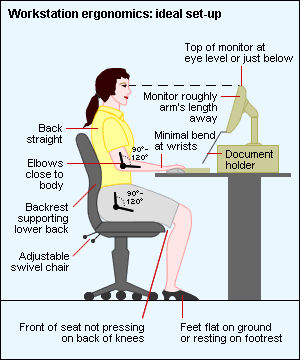
- Top of monitor at eye level or just below
- Monitor roughly arm's length away
- Minimal bend at wrists.
- Back straight
- Elbows close to body at 90 to 120 degree bend.
- Backrest supporting lower back
- Hips at 90 to 120 degree bend
- Adjustable swivel chair
- Front of seat not pressing on back of knees
- Feet flat on ground or resting on footrest
Your feet should be placed comfortably on the floor. A footrest is an acceptable option as an alternate position or if the feet cannot reach the floor when the chair is placed at a proper working height in relationship to the desktop.
Work Habits
- Employees should be touch typists.
- Employees should allow hands to float over the keyboard when “typing”.
- Employees should not overuse wrist rests.
- Employees should operate the mouse by using the entire forearm and shoulder and not by moving the hand and wrist only.
- Employees should take frequent mini breaks from keying.
- Employees should ensure that their visual acuity has been tested within the past year.
FLEXIBILITY/STRETCHING EXERCISES
Neck Stretch

- Tilt ear toward shoulder.
- Reach up and touch top of head with palm to hold in tilted position.
- Hold 5-10 seconds. Repeat 2-3 times (come out of stretch very slowly.) Reverse side.
Overhead Reach
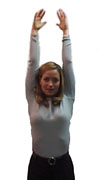
- Take a deep breath and reach up over head with both arms.
- Hold 5-10 seconds.
- Exhale and lower slowly.
- Repeat 2-3 times.
Shoulder Pinch
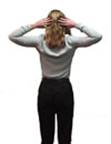
- Place arms behind head being careful not to press hand into head.
- Relax shoulders, and squeeze shoulder blades together while keeping shoulders back and down.
- Hold 5-10 seconds. Repeat 2-3 times.
Chair Rotation Stretch
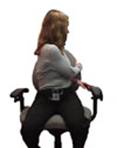
- Sit in chair, and if you can, wrap feet around chair legs.
- Reach across body and grab back of chair.
- Pull gently to increase stretch in mid back.
- Hold 5-10 seconds. Repeat 5 times.
Arms Behind Back Stretch
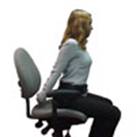
- Hold hands behind back, and grasp hands together.
- Pull shoulder blades back and down.
- Hold 5 seconds. Repeat 5 times.
Wrist Flexed/Fingers Straight
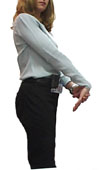
- Hold arm straight at waist height.
- With fingers of other hand, gently press down above the knuckles-bending wrist down. **(Do not hold at the fingers to push down.)** Hold for 5-10 seconds.
- Keep shoulder relaxed when stretching.
- Repeat 2-3 times.
Wrist Extended/Fingers Point Up
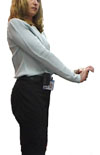
- Hold arm straight at waist height with palm facing away from you and fingers pointing up.
- Hold onto palm of hand and stretch wrist back. ** (Do not pull on fingers.) **
- Make sure the fingers and thumb (on the hand that is pushing the other hand back) are kept together.
- Hold 5-10 seconds. Repeat 2-3 times.
Wrist Extended/Fingers Point Down
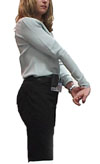
- Do as above, but with fingers pointing towards the floor.
- Hold 5-10 seconds. Repeat 2-3 times.